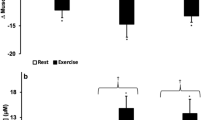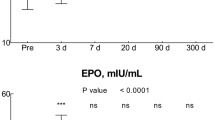Abstract
Since Bert (1878) and Barcroft (1925), studies on hypoxia are realized by lowering ambient O2 partial pressure (PO2) either by barometric pressure reduction (hypobaric hypoxia HH) or by lowering the O2 fraction (normobaric hypoxia NH). Today, a question is still debated: "are there any physiological differences between HH and NH for the same ambient PO2?" Since published studies are scarce and controversial, we submitted 18 subjects in a random order to a 40-min HH test and to a 40-min NH test at an ambient PO2 equal to 120 hPa (4500 m). Cardioventilatory variables [breathing frequency (f), tidal volume (V t), minute ventilation (V̇E), O2 and CO2 end-tidal fractions or pressures (FETO2 and FETCO2 or PETO2 and PETCO2 respectively), heart rate (HR) and O2 arterial saturation by pulse oxymetry (SpO2)] were measured throughout the tests. At the end of the tests, arterial blood samples were taken to measure arterial blood gases [O2 and CO2 arterial partial pressures (PaO2 and PaCO2), pH and O2 arterial saturation (SaO2)]. Results show that during HH compared to NH, f is greater (P≤0.001), V t and V̇E under BTPS conditions are lower (P≤0.05), and FETO2 and FETCO2 are higher (P≤0.05). However, PETO2 does not change during the last 25 min of the tests, and neither does PETCO2 throughout the tests. HR is higher (P≤0.05) and SpO2 lower (P≤0.05) in HH compared to NH. Arterial blood data reveal that hypoxemia, hypocapnia and blood alkalosis are greater in HH compared to NH and that SaO2 is lower (P≤0.05). It is concluded that the physiological responses of humans submitted to an acute hypoxia at a PO2 equal to 120 hPa differ according to the type of hypoxia. Compared to NH, HH leads to a greater hypoxemia, hypocapnia, blood alkalosis and a lower O2 arterial saturation. These physiological differences could be the consequence of an increase in dead space ventilation, probably related to the barometric pressure reduction, and could be grouped together under the term "the specific response to hypobaric hypoxia". Knowledge of this specific response could improve the comprehension, prevention and treatment of altitude illnesses in the future.


Similar content being viewed by others
References
Barcroft J (ed) (1925) Respiratory function of the blood, Part I. Cambridge University Press, New York
Bert P (1878) La pression barométrique: recherches de physiologie expérimentale. Masson, Paris, p 1168
Dejours P, Dejours S (1992) The effects of barometric pressure according to Paul Bert: the question today. Int J Sports Med 13 [Suppl. 1] S1–S5
Dejours P, Puccinelli R, Armand J, Dicharry M (1965) Concept and measurement of ventilatory sensitivity to carbon dioxide. J Appl Physiol 20 (5):890–897
Farhi LE, Rahn H (1960) Dynamics of changes in carbon dioxide stores. Anesthesiology 21 (6):604–614
Levine BD, Kubo K, Kobayashi T, Fukushima M, Shibamoto T, Ueda G (1988) Role of barometric pressure in pulmonary fluid balance and oxygen transport. J Appl Physiol 64 (1):419–428
Loeppky JA, Scotto P, Roach RC (1996) Acute ventilatory response to simulated altitude, normobaric hypoxia, and hypobaria. Aviat Space Environ Med 67 (11):1019–1922
Loeppky JA, Icenogle M, Scotto P, Robergs R, Hinghofer Szalkay H, Roach RC (1997) Ventilation during simulated altitude, normobaric hypoxia and normoxic hypobaria. Respir Physiol 107 (3):231–239
Roach RC, Loeppky JA, Robergs R, Maes D, Sandoval D, Letellier JP (1994) Fluid balance in humans at high altitude: does hypobaria plays a role ? [abstract] FASEB J 8(4):A553
Roach RC, Loeppky A (1995) Does hypobaria play a role in the development of the high altitude illnesses ? In: Sutton JR, Houston CS, Coates G (eds) Hypoxia and the brain. Queen City Printers, Burlington, Va., pp 277–283
Roach RC, Loeppky JA, Icenogle MV (1996) Acute mountain sickness: increased severity during simulated altitude compared with normobaric hypoxia. J Appl Physiol 81 (5):1908–1910
Saltzman HA, Salzano JV, Blenkarn GD, Kylstra JA (1971) Effects of pressure on ventilation and gas exchange in man. J Appl Physiol 30 (4):443–449
Shams H, Powell FL, Hempleman SC (1990) Effects of normobaric and hypobaric hypoxia on ventilation and arterial blood gases in ducks. Respir Physiol 80 (2–3):163–170
Tucker A, Reeves JT, Robertshaw D, Grover RF (1983) Cardiopulmonary response to acute altitude exposure: water loading and denitrogenation. Respir Physiol 54 (3):363–380
Wagner PD (1977) Diffusion and chemical reaction in pulmonary gas exchange. Physiol Rev 57 (2):257–312
Acknowledgements
We gratefully thank Professor Pierre Dejours, Membre de l'Académie des Sciences de Paris for his help and for his acceptance to review this manuscript. The contributions of subjects, especially the subjects of the Mountain Club of the Essa Lyon-Bron, are acknowledged as well as the technical assistance of A-M. Hanniquet, F. Grimbert, S. Martin and J. Denis. A special recognition is given to Médecin général Jacques Bittel.
Author information
Authors and Affiliations
Corresponding author
Rights and permissions
About this article
Cite this article
Savourey, G., Launay, JC., Besnard, Y. et al. Normo- and hypobaric hypoxia: are there any physiological differences?. Eur J Appl Physiol 89, 122–126 (2003). https://doi.org/10.1007/s00421-002-0789-8
Accepted:
Published:
Issue Date:
DOI: https://doi.org/10.1007/s00421-002-0789-8




